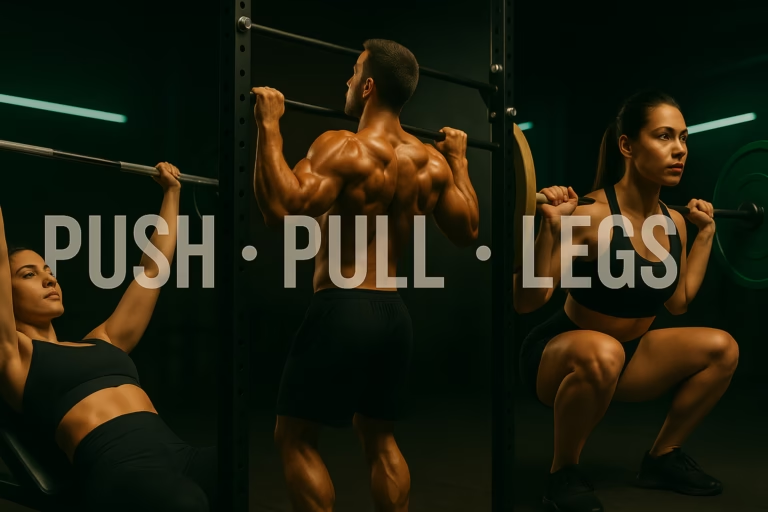The Ultimate Guide to the BEST PUSH – PULL – LEGS WORKOUT
If you’re looking to build strength, muscle, and endurance efficiently, the BEST PUSH – PULL – LEGS WORKOUT routine is your go-to fitness plan. This training split divides exercises into three focused categories—Push, Pull, and Legs—ensuring balanced muscle growth and recovery.
Why Choose the BEST PUSH – PULL – LEGS WORKOUT?
The BEST PUSH – PULL – LEGS WORKOUT helps you target every major muscle group with precision. Push days focus on the chest, shoulders, and triceps, Pull days hit the back and biceps, while Leg days strengthen your lower body. This structure allows consistent progression and minimizes overtraining.
Push Day: Building Strength and Power
On your Push day in the BEST PUSH – PULL – LEGS WORKOUT, you’ll perform movements like bench presses, shoulder presses, and tricep dips. These compound exercises improve upper-body power and promote muscle symmetry.
Pull Day: Enhancing Back and Grip Strength
The Pull section of the BEST PUSH – PULL – LEGS WORKOUT targets your lats, traps, and biceps with exercises such as pull-ups, barbell rows, and face pulls. This not only builds a strong back but also enhances posture and pulling endurance.
Leg Day: Power, Stability, and Growth
No workout routine is complete without legs. The BEST PUSH – PULL – LEGS WORKOUT includes squats, lunges, and deadlifts to develop leg power and overall body balance. Strong legs are the foundation of a fit, athletic body.
Benefits of the BEST PUSH – PULL – LEGS WORKOUT
Promotes balanced muscle development
Supports progressive overload and recovery
Suitable for beginners and advanced lifters
Flexible for both home and gym training
By following the BEST PUSH – PULL – LEGS WORKOUT, you’ll notice consistent strength gains, better endurance, and visible muscle definition over time.
Who Should Use A Push/Pull/Legs workout:-
A Push/Pull/Legs (PPL) split is a great option for intermediate to advanced lifters who have laid a good foundation of training with a basic full-body or upper/lower routine, and would like something more structured to ensure they effectively target each muscle group. It is a good option for people focusing on muscle growth, strength, or sheer training volume because it allows for focused recovery of a specific muscle group while keeping the training frequency high. Ideally this split can be run 3, 4, 5, or 6 days a week
But if the lifter can hit at least 3 then it will work out fine because of its natural flexibility, and the ability to be run once or twice weekly. That’s why you see athletes, bodybuilders, and dedicated recreational lifters use the PPL split so often; it balances workload, recovery, and progression in a way that allows for a sustainable long-term plan for building a strong and well proportioned physique.
PPL (Push–Pull–Legs):- work outimplementation details 3–6 days a week based on recovery and goals.
Day 1 – Push (Chest, Shoulders, Triceps):-
Goal: Train pushing movements that target the upper body front side.
Bench Press (Barbell/Dumbbell) – 4 sets × 6–8 reps
Overhead Shoulder Press – 3 sets × 8–10 reps
Incline Dumbbell Press – 3 sets × 8–10 reps
Lateral Raises – 3 sets × 12–15 reps
Triceps Dips or Rope Pushdowns – 3 sets × 10–12 reps
Day 2 – Pull (Back, Biceps, Rear Delts):-
Goal: Upper body back side pull movements
Pull-Ups or Lat Pulldown – 4 sets × 6–8 reps
Barbell or Dumbbell Row – 4 sets × 8–10 reps
Face Pulls – 3 sets × 12–15 reps
Barbell or Dumbbell Bicep Curls – 3 sets × 10–12 reps
Hammer Curls – 3 sets × 10–12 reps
Day 3 – Legs (Quads, Hamstrings, Glutes, Calves):-
Goal: Strengthen lower body through compound & isolation work.
Barbell Squats – 4 sets × 6–8 reps
Romanian Deadlift – 4 sets × 8–10 reps
Walking Lunges – 3 sets × 10–12 steps per leg
Leg Press or Bulgarian Split Squat – 3 sets × 10–12 reps
Standing Calf Raises – 4 sets × 12–15 reps
Weekly Schedule Examples:-
- 3 days/week: PPL once each week.
6 days/week: PPL repeated twice (Push–Pull–Legs–Push–Pull–Legs).

